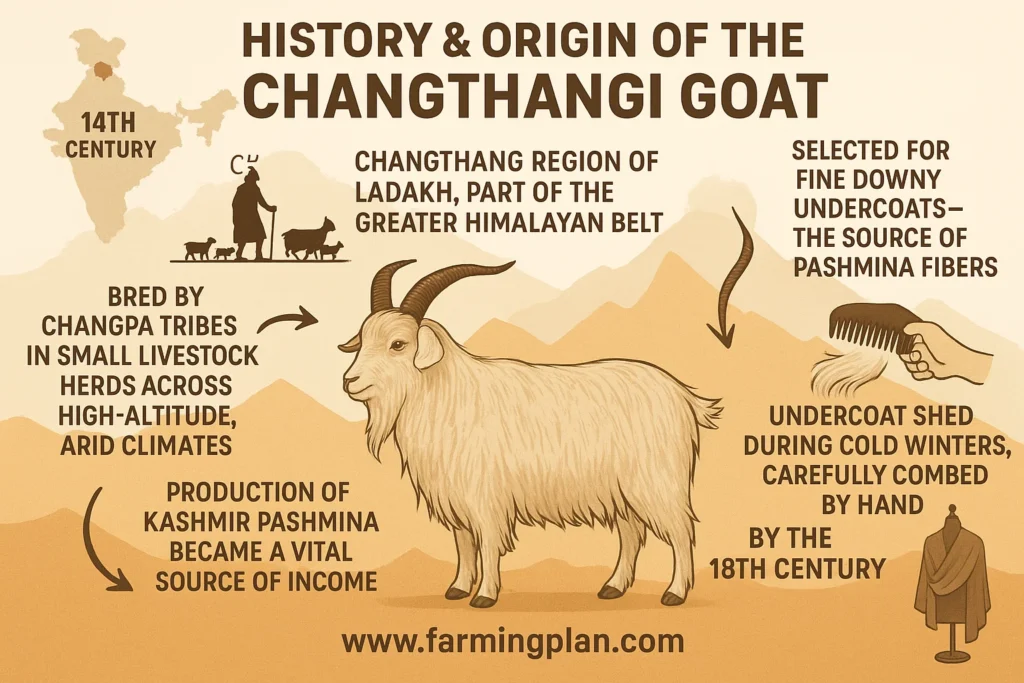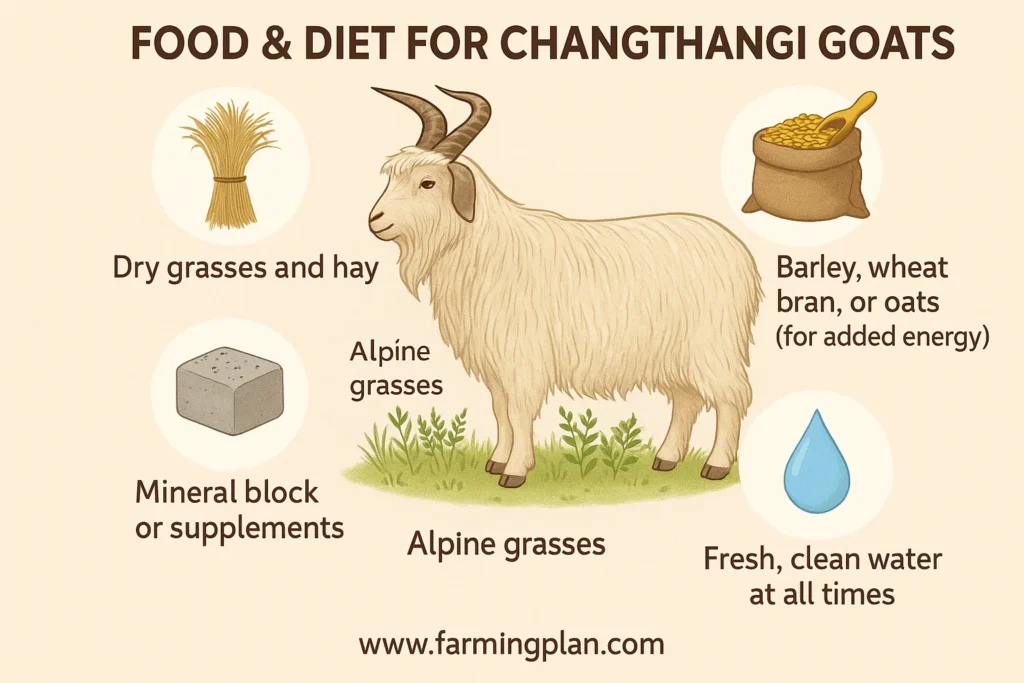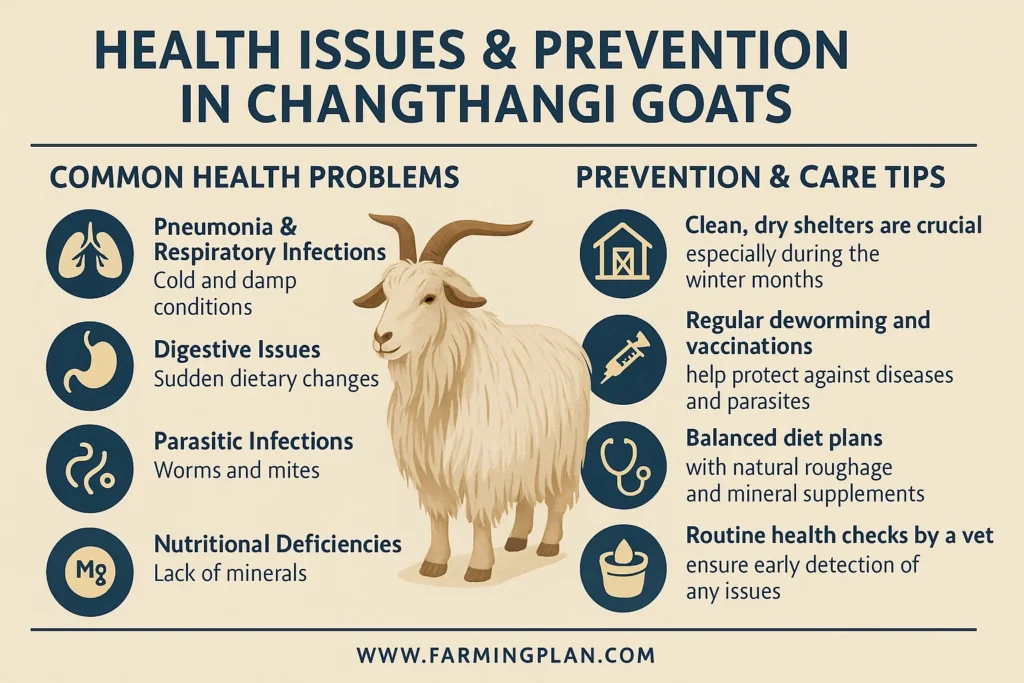The Changthangi Goat, also known as the Changthangi Cashmere Goat, is a rare and remarkable breed native to Ladakh, India’s cold, high-altitude Himalayan regions. These goats are famous for their super-soft undercoat, the source of the world’s finest Pashmina wool. For centuries, they have played a vital role in the Pashmina industry, supporting local herders and the traditional art of Pashmina shawl weaving. The harsh climate conditions of their native region have shaped them into hardy, resilient animals with unique physical characteristics like curved horns, thick coat hair, and a warm, downy undercoat that grows during winter months.

History & Origin of the Changthangi Goat
The Changthangi Goat has a deep-rooted history that stretches back to the 14th century in the Changthang region of Ladakh, part of the greater Himalayan belt. Bred by the nomadic Changpa tribes, these goats were raised in small livestock herds across the high-altitude, arid climates of the region. Over centuries, the Changpas developed a unique understanding of these animals, selecting only those with the finest downy undercoats—the base of luxurious Pashmina fibers. This undercoat is shed naturally during the cold winters and then carefully combed by hand.

The production of Kashmir Pashmina from these goats became a vital source of income and a symbol of wealth and prestige. By the 18th century, the Pashmina shawls of Kashmir gained global fame and were admired by royalty and aristocrats worldwide. Despite challenges from fake Pashmina imports and climate change, the Changthangi goat remains at the heart of authentic Pashmina production—a living link to a rich cultural and economic heritage that still thrives in the mountains today.
Reads More: British Alpine Goat Guide: Elite Dairy Performer
Characteristics of the Changthangi Goat
The Changthangi Goat is specially adapted to survive in harsh conditions of the Himalayan regions, especially the Changthang plateau. These remarkable animals are medium-sized with a strong, sturdy frame. One of their most distinct features is their curved horns, which can be dark brown or pale brown and vary in size depending on the goat’s age and sex. They typically have long, coarse coat hair outside, which protects them from the freezing climate, and a super-soft undercoat beneath it—the prized source of Changthangi wool or Pashmina.
Their physical characteristics include a thick neck, a broad chest, and strong legs built for walking long distances in rocky, mountainous areas. The color of the coat can range from white to shades of brown or even gray. These cashmere goats grow their insulating undercoat in the winter months, which sheds naturally in spring and is carefully harvested by local herders.
Every adult Changthangi goat produces 70 to 500 grams of Pashmina each year, making its fiber incredibly rare and valuable. The goats’ lifespan is typically around 10 to 12 years, and they are raised in goat herds under close care.
Nature & Temperament of the Changthangi Goat
The Changthangi Goat is known for its calm, alert, and resilient temperament, shaped by generations of survival in Ladakh’s cold, mountainous regions. These goats are naturally hardy and well-suited to living in harsh climates, where temperatures often drop below freezing. Despite their tough environment, they are gentle and tend to form strong bonds within their herds.
They are not aggressive and usually behave well around humans, especially when raised with regular contact from a young age. This makes them manageable for experienced breeders, farmers, and even hobbyists interested in sustainable livestock farming. However, because they are bred to roam wide open spaces, Changthangi goats may not adjust easily to enclosed or warm environments.
Their behavior reflects their need for movement, fresh air, and a balanced diet that mirrors their natural grazing patterns. They are relatively low-maintenance and loyal animals if provided with the right environment, perfectly suited to traditional herding systems in high-altitude regions.
Food & Diet for Changthangi Goats
The Changthangi Goat survives on a balanced diet supporting its health and producing high-quality Pashmina wool. In their native Himalayan habitat, these goats graze on naturally growing alpine grasses, herbs, and shrubs, which provide essential nutrients even in arid climate conditions. Their diet is rich in roughage and includes wild plants that thrive in high-altitude regions, giving them the energy to grow their prized undercoat during the cold winters.

It’s important to mimic their natural food sources as closely as possible for domestic or farm-raised goats. A healthy mix can include:
- Dry grasses and hay
- Barley, wheat bran, or oats (for added energy)
- Mineral blocks or supplements (especially calcium and phosphorus)
- Fresh, clean water at all times
Avoid feeding Changthangi goats foods high in starch or sugar, as well as anything moldy or spoiled. Their sensitive digestive systems can be affected by sudden changes in diet, so always introduce new foods slowly. A good diet plan not only maintains their health but also ensures the production of the finest Pashmina fibers. Proper feeding directly affects the quality of Pashmina, which is determined during combing and processing.
Usage & Purpose of the Changthangi Goat
The Changthangi Goat plays a crucial role in both the economic and cultural life of the Himalayan people. Its most famous contribution is the production of Changthangi wool, also known as Pashmina—the raw material used to make the world-renowned Pashmina shawls of Kashmir. These shawls, woven from the goat’s soft undercoat, are prized for their warmth, softness, and lightweight, making them a high-quality fabric in global fashion and the textile industry.
Beyond fiber production, these goats serve as a major source of income for the Changpa herders of Ladakh, supporting livelihoods that have lasted for centuries. The Pashmina industry, including weaving, processing, and exporting, relies heavily on the health and well-being of these goats.
Their wool is collected once a year, and each goat yields only a small amount—making every gram valuable. While not typically raised for meat or milk, their role as fiber-producing animals makes them one of the most economically impactful livestock breeds in India. As demand for authentic Pashmina products grows, the importance of the Changthangi Cashmere Goat continues to rise both locally and globally.
“From the cold heights of Ladakh comes a warmth the world cherishes — the Changthangi Goat and its golden fleece.”
Special Features of the Changthangi Goat
The Changthangi Goat stands out for several unique traits that make it one of the most valuable breeds in the world:
- Super-Soft Undercoat: The goat’s downy undercoat is the source of the world-famous Pashmina wool, known for being finer, softer, and warmer than regular sheep wool or standard cashmere.
- Survival in Harsh Climates: This breed thrives in high-altitude regions above 13,000 feet, where temperatures fall below -20°C. Few animals can survive, let alone produce luxury fiber, under such extreme conditions.
- Low Wool Yield, High Value: Each goat produces only about 70–500 grams of raw Pashmina per year, making it one of the finest and rarest fibers on the planet.
- Distinctive Curved Horns: Both males and females often have curved horns, adding to their majestic appearance and helping identify the breed.
- Cultural and Economic Heritage: These goats have been central to the culture of Pashmina production in Ladakh for centuries, supporting traditional lifestyles and the regional textile industry.
- Natural Fiber Growth Cycle: Their undercoat grows during cold winters and is naturally shed in spring, following the seasons—no need for artificial wool stimulation.
These features make the Changthangi Cashmere Goat a remarkable animal—one that is not just a breed but a heritage icon of India’s highlands.
Health Issues & Prevention in Changthangi Goats
Although Changthangi Goats are highly resilient due to their adaptation to harsh climates, they are still vulnerable to certain health challenges—especially when moved away from their native high-altitude regions.

Common Health Problems:
- Pneumonia & Respiratory Infections: Cold and damp conditions outside their natural dry, cold habitat can lead to breathing problems.
- Digestive Issues: Sudden dietary changes or contaminated food can result in bloating or diarrhea.
- Parasitic Infections: Internal and external parasites like worms and mites can affect wool quality and general health.
- Nutritional Deficiencies: Lack of minerals like calcium, phosphorus, and copper can weaken bones and lower fiber production.
Prevention & Care Tips:
- Clean, dry shelters are crucial—especially during the winter months.
- Regular deworming and vaccinations help protect against diseases and parasites.
- Balanced diet plans with natural roughage and mineral supplements keep goats healthy and productive.
- Routine health checks by a vet ensure early detection of any issues.
- Clean drinking water is a must to prevent digestive problems.
By maintaining proper goat herding practices and keeping close track of their health, breeders and farmers can ensure these remarkable animals live longer and continue producing high-quality Pashmina wool.
Reads More: Burford Brown Chicken: The Perfect Breed For Happy, Productive Flocks
Step-by-Step Farming Guide for Changthangi Goats
Raising Changthangi Goats requires knowledge, patience, and respect for their unique needs. Here’s a simple step-by-step guide to help breeders and farmers care for these valuable animals:
Choose the Right Location
- Select a high-altitude, cool climate, if possible, to mimic their native Himalayan environment.
- Provide ample space for grazing and exercise.
Set Up Shelter
- Build clean, dry, and well-ventilated shelters that protect goats from extreme cold, wind, and rain during harsh winter months.
- Use natural materials to maintain appropriate humidity and temperature.
Manage Herds
- Keep goats in small herds for better health monitoring and natural social behavior.
- Regularly inspect for signs of stress or illness.
Provide Balanced Nutrition
- Offer fresh grasses, hay, and shrubs similar to their native diet.
- Supplement with grains and minerals to support fiber growth and overall health.
- Ensure constant access to clean drinking water.
Regular Health Checks
- Schedule periodic veterinary visits for deworming, vaccinations, and health screening.
- Monitor for common diseases like respiratory infections and parasites.
Wool Harvesting
- Collect raw Pashmina wool during the spring when the soft undercoat naturally sheds.
- Use traditional combing methods to separate fine fibers from coarse hair.
Maintain Record Keeping
- Track health, breeding, and wool yield for each animal to improve herd quality over time.
Promote Ethical Farming
- Avoid overgrazing and maintain balanced diets to reduce environmental impact.
- Support sustainable practices that protect native goat herds and their natural habitats.
By following these steps, farmers and breeders can ensure the well-being of Changthangi Cashmere Goats and sustain the production of authentic Pashmina products.
Expert Tips & Best Practices for Raising Changthangi Goats
- Maintain a Clean Environment: Regularly clean shelters and grazing areas to prevent disease and improve wool quality.
- Provide a Diet Rich in Roughage: Ensure goats have access to natural grasses and shrubs, mimicking their native Himalayan diet for optimal undercoat growth.
- Control Parasites Proactively: Use routine deworming schedules and check for external parasites to avoid health issues that can affect fiber production.
- Use Traditional Shearing and Combing Methods: Preserve the integrity of the finest Pashmina fibers by employing skilled artisans familiar with traditional methods.
- Monitor Climate Conditions: Adapt care strategies according to seasonal changes, especially during harsh winters, to maintain goat health and wool yield.
- Limit Stress in Herds: Keep herds small and stable to encourage natural behaviors and reduce stress-related health problems.
- Selective Breeding: Focus on breeding goats with the finest soft undercoat and robust health for improved Pashmina quality.
- Invest in Training: Learn from experienced herders and artisans to improve wool harvesting and processing techniques.
- Support Sustainable Practices: Balance livestock grazing with environmental conservation to reduce the irreversible impact on the Himalayan regions.
- Stay Informed on Market Trends: Understand demand for authentic Pashmina products and guard against fake Pashmina imports by maintaining high standards.
FAQs
What is a Changthangi goat?
The Changthangi goat is a breed native to the high-altitude Himalayan regions, known for producing the rare and valuable Pashmina wool used in making luxurious shawls.
How much wool does a Changthangi goat produce?
Each Changthangi goat produces about 70 to 500 grams of fine Pashmina wool annually, harvested from their soft undercoat during the spring.
What makes Changthangi wool special?
Changthangi wool, or Pashmina, is softer, finer, and warmer than regular sheep wool or typical cashmere, thanks to the goat’s super-soft undercoat adapted to cold mountain climates.
How do farmers care for Changthangi goats?
Farmers provide a balanced diet rich in natural grasses, clean shelter during harsh winters, regular health check-ups, and traditional combing methods to maintain wool quality.
Are Changthangi goats endangered?
While not officially endangered, Changthangi goats face challenges due to climate change and habitat loss. Sustainable farming and breeding programs help preserve this valuable breed.
Conclusion
The Changthangi Goat is a remarkable breed native to the harsh, high-altitude Himalayan regions, prized worldwide for its production of the finest Pashmina wool. With its unique super-soft undercoat, curved horns, and ability to thrive in extreme climates, this goat plays a vital role in the Pashmina industry and local economies. Proper care, balanced diet, and sustainable farming practices are essential to maintaining the health of these goats and ensuring the ongoing supply of authentic Pashmina products. As global demand for high-quality Changthangi cashmere continues to rise, protecting and supporting this breed becomes increasingly important for preserving both cultural heritage and economic livelihood in Kashmir and Ladakh.
